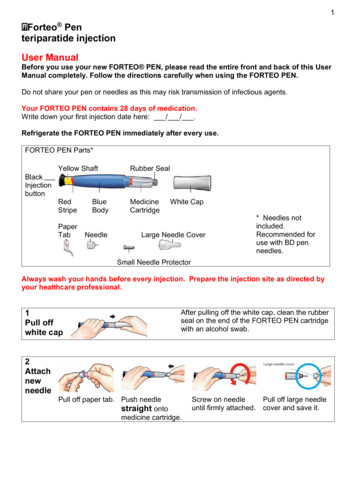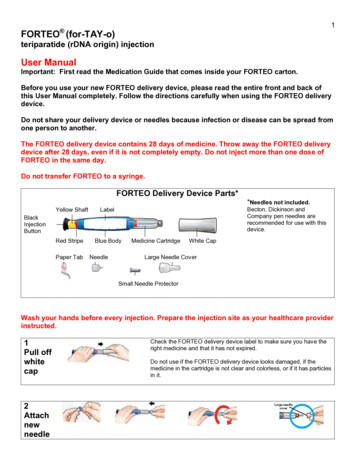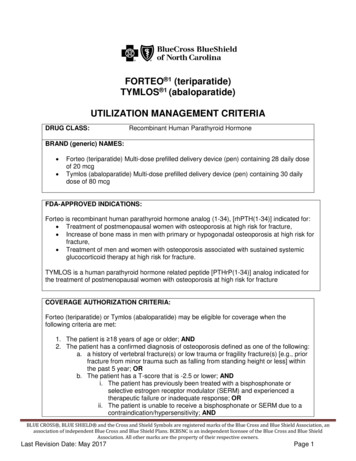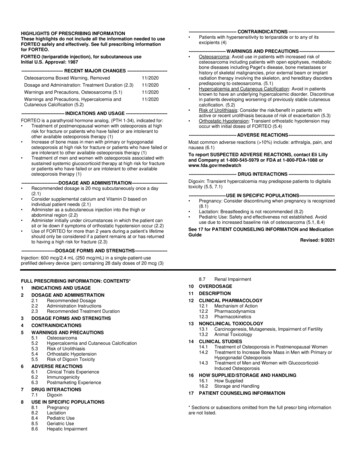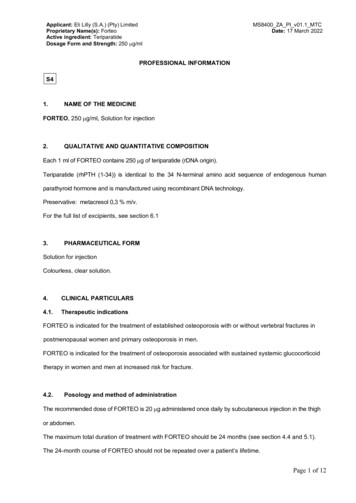
Transcription
1 PA 9244FSAMPFORTEOteriparatide (rDNA origin) injection750 mcg/3 mLWARNINGIn male and female rats, teriparatide caused an increase in the incidence of osteosarcoma(a malignant bone tumor) that was dependent on dose and treatment duration. The effectwas observed at systemic exposures to teriparatide ranging from 3 to 60 times the exposurein humans given a 20-mcg dose. Because of the uncertain relevance of the rat osteosarcomafinding to humans, teriparatide should be prescribed only to patients for whom thepotential benefits are considered to outweigh the potential risk. Teriparatide should not beprescribed for patients who are at increased baseline risk for osteosarcoma (including thosewith Paget’s disease of bone or unexplained elevations of alkaline phosphatase, openepiphyses, or prior external beam or implant radiation therapy involving the skeleton) (seeWARNINGS and PRECAUTIONS, Carcinogenesis).DESCRIPTIONFORTEO [teriparatide (rDNA origin) injection] contains recombinant human parathyroidhormone (1-34), [rhPTH(1-34)], which has an identical sequence to the 34 N-terminal aminoacids (the biologically active region) of the 84-amino acid human parathyroid hormone.Teriparatide has a molecular weight of 4117.8 daltons and its amino acid sequence is shownbelow: Teriparatide (rDNA origin) is manufactured by Eli Lilly and Company using a strain ofEscherichia coli modified by recombinant DNA technology. FORTEO is supplied as a sterile,colorless, clear, isotonic solution in a glass cartridge which is pre-assembled into a disposablepen device for subcutaneous injection. Each prefilled delivery device is filled with 3.3 mL todeliver 3 mL. Each mL contains 250 mcg teriparatide (corrected for acetate, chloride, and watercontent), 0.41 mg glacial acetic acid, 0.1 mg sodium acetate (anhydrous), 45.4 mg mannitol,3 mg Metacresol, and Water for Injection. In addition, hydrochloric acid solution 10% and/orsodium hydroxide solution 10% may have been added to adjust the product to pH 4.Each cartridge pre-assembled into a pen device delivers 20 mcg of teriparatide per dose eachday for up to 28 days.See accompanying User Manual: Instructions for Use.
2CLINICAL PHARMACOLOGYMechanism of ActionEndogenous 84-amino-acid parathyroid hormone (PTH) is the primary regulator of calciumand phosphate metabolism in bone and kidney. Physiological actions of PTH include regulationof bone metabolism, renal tubular reabsorption of calcium and phosphate, and intestinal calciumabsorption. The biological actions of PTH and teriparatide are mediated through binding tospecific high-affinity cell-surface receptors. Teriparatide and the 34 N-terminal amino acids ofPTH bind to these receptors with the same affinity and have the same physiological actions onbone and kidney. Teriparatide is not expected to accumulate in bone or other tissues.The skeletal effects of teriparatide depend upon the pattern of systemic exposure. Once-dailyadministration of teriparatide stimulates new bone formation on trabecular and cortical(periosteal and/or endosteal) bone surfaces by preferential stimulation of osteoblastic activityover osteoclastic activity. In monkey studies, teriparatide improved trabecular microarchitectureand increased bone mass and strength by stimulating new bone formation in both cancellous andcortical bone. In humans, the anabolic effects of teriparatide are manifest as an increase inskeletal mass, an increase in markers of bone formation and resorption, and an increase in bonestrength. By contrast, continuous excess of endogenous PTH, as occurs in hyperparathyroidism,may be detrimental to the skeleton because bone resorption may be stimulated more than boneformation.Human PharmacokineticsTeriparatide is extensively absorbed after subcutaneous injection; the absolute bioavailability isapproximately 95% based on pooled data from 20-, 40-, and 80-mcg doses. The rates ofabsorption and elimination are rapid. The peptide reaches peak serum concentrations about30 minutes after subcutaneous injection of a 20-mcg dose and declines to non-quantifiableconcentrations within 3 hours.Systemic clearance of teriparatide (approximately 62 L/hr in women and 94 L/hr in men)exceeds the rate of normal liver plasma flow, consistent with both hepatic and extra-hepaticclearance. Volume of distribution, following intravenous injection, is approximately 0.12 L/kg.Intersubject variability in systemic clearance and volume of distribution is 25% to 50%. Thehalf-life of teriparatide in serum is 5 minutes when administered by intravenous injection andapproximately 1 hour when administered by subcutaneous injection. The longer half-lifefollowing subcutaneous administration reflects the time required for absorption from theinjection site.No metabolism or excretion studies have been performed with teriparatide. However, themechanisms of metabolism and elimination of PTH(1-34) and intact PTH have been extensivelydescribed in published literature. Peripheral metabolism of PTH is believed to occur bynon-specific enzymatic mechanisms in the liver followed by excretion via the kidneys.Special PopulationsPediatric — Pharmacokinetic data in pediatric patients are not available (see WARNINGS).Geriatric — No age-related differences in teriparatide pharmacokinetics were detected (range31 to 85 years).Gender — Although systemic exposure to teriparatide was approximately 20% to 30% lowerin men than women, the recommended dose for both genders is 20 mcg/day.Race — The populations included in the pharmacokinetic analyses were 98.5% Caucasian. Theinfluence of race has not been determined.
3Renal insufficiency — No pharmacokinetic differences were identified in 11 patients with mildor moderate renal insufficiency [creatinine clearance (CrCl) 30 to 72 mL/min] administered asingle dose of teriparatide. In 5 patients with severe renal insufficiency (CrCl 30 mL/min), theAUC and T1/2 of teriparatide were increased by 73% and 77%, respectively. Maximum serumconcentration of teriparatide was not increased. No studies have been performed in patientsundergoing dialysis for chronic renal failure (see PRECAUTIONS).Heart failure — No clinically relevant pharmacokinetic, blood pressure, or pulse ratedifferences were identified in 13 patients with stable New York Heart Association Class I to IIIheart failure after the administration of two 20-mcg doses of teriparatide.Hepatic insufficiency — Non-specific proteolytic enzymes in the liver (possibly Kupffer cells)cleave PTH(1-34) and PTH(1-84) into fragments that are cleared from the circulation mainly bythe kidney. No studies have been performed in patients with hepatic impairment.Drug InteractionsHydrochlorothiazide — In a study of 20 healthy people, the coadministration ofhydrochlorothiazide 25 mg with teriparatide did not affect the serum calcium response toteriparatide 40 mcg. The 24-hour urine excretion of calcium was reduced by a clinicallyunimportant amount (15%). The effect of coadministration of a higher dose ofhydrochlorothiazide with teriparatide on serum calcium levels has not been studied.Furosemide — In a study of 9 healthy people and 17 patients with mild, moderate, or severerenal insufficiency (CrCl 13 to 72 mL/min), coadministration of intravenous furosemide (20 to100 mg) with teriparatide 40 mcg resulted in small increases in the serum calcium (2%) and24-hour urine calcium (37%) responses to teriparatide that did not appear to be clinicallyimportant.Human PharmacodynamicsEffects on mineral metabolismTeriparatide affects calcium and phosphorus metabolism in a pattern consistent with the knownactions of endogenous PTH (eg, increases serum calcium and decreases serum phosphorus).Serum calcium concentrationsWhen teriparatide 20 mcg is administered once daily, the serum calcium concentrationincreases transiently, beginning approximately 2 hours after dosing and reaching a maximumconcentration between 4 and 6 hours (median increase, 0.4 mg/dL). The serum calciumconcentration begins to decline approximately 6 hours after dosing and returns t
clearance. Volume of distribution, following intravenous injection, is approximately 0.12 L/kg. Intersubject variability in systemic clearance and volume of distribution is 25% to 50%. The half-life of teriparatide in serum is 5 minutes when administered by intravenous injection and approximately 1 hour when administered by subcutaneous injection.
